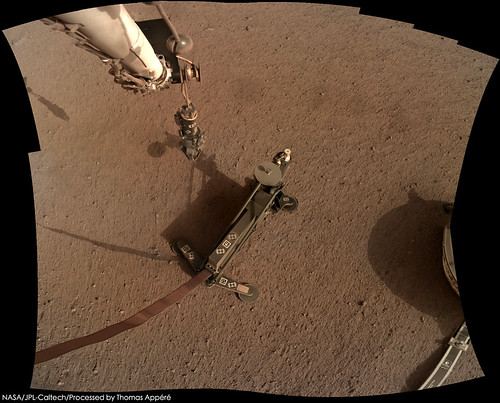ICC view animGIF of the flyin' SEISer arrival and landing
Click to view attachment
Full Version: InSight Surface Operations
Pages: 1, 2, 3, 4, 5, 6, 7, 8, 9, 10, 11, 12, 13, 14, 15, 16, 17, 18, 19, 20, 21, 22, 23, 24, 25, 26
MRO has spotted SEIS deployed.


SEIS Installation 3, the installation of the Wind and Thermal Shield, is posted here (translated by Google in the first)
https://translate.google.com/translate?sl=a...-installation-3
https://www.seis-insight.eu/fr/actualites/4...-installation-3
They were briefly worried about the skirt being stuck, but it's good.
https://translate.google.com/translate?sl=a...-installation-3
https://www.seis-insight.eu/fr/actualites/4...-installation-3
QUOTE
the thermal performances are very good, and the impact on the temperature variations of the different components of the seismometer is clearly visible. Finally, the reduction of the noise level is absolutely spectacular
They were briefly worried about the skirt being stuck, but it's good.
I aligned IDC pictures of the HP3 capture with the background to see the movement of the arm:
Click to view attachment
Click to view attachment
"At that moment, nothing that moves on Mars will be able to escape the seismometer of the probe InSight "
That sounds awesome.
That sounds awesome.
Hmm. I suppose that means that it'll be able to pick up those seasonal polar cap landslides in the north, then. Hopefully there will be an effort to correlate seismic signals with those events, presumably via MRO before-and-after imagery.
Hmm. I suppose that means that it'll be able to pick up those seasonal polar cap landslides in the north, then. Hopefully there will be an effort to correlate seismic signals with those events, presumably via MRO before-and-after imagery.
From a scientific point of view, I have to admit that I may have been a little bit over enthusiastic with the last sentence of the WTS news quoted just above !
Given the sensibility of SEIS's seismic sensors, and the noise level we have under the WTS, we are in a good place to detect very small ground displacements. But, it is only true if the seismic energy is able to reach the seismometer ! If the seismic waves are strongly attenuated by something (such as the regolith ?), if SEIS is in a shadow zone of a given quake, or if the source is very far away (epicenter opposite to the landing site, meaning on the other side of the planet, etc.), we will not be able to detect something. That's the problem with having only one seismometer. Of course, planetary geophysicists wanted a seismic/atm networks from the very beginning (see for example the incredible scope of the MESUR project in 1990's), but having InSight with its single seismometer at the surface of Mars was already excruciatingly difficult.
HP3 is on the ground!
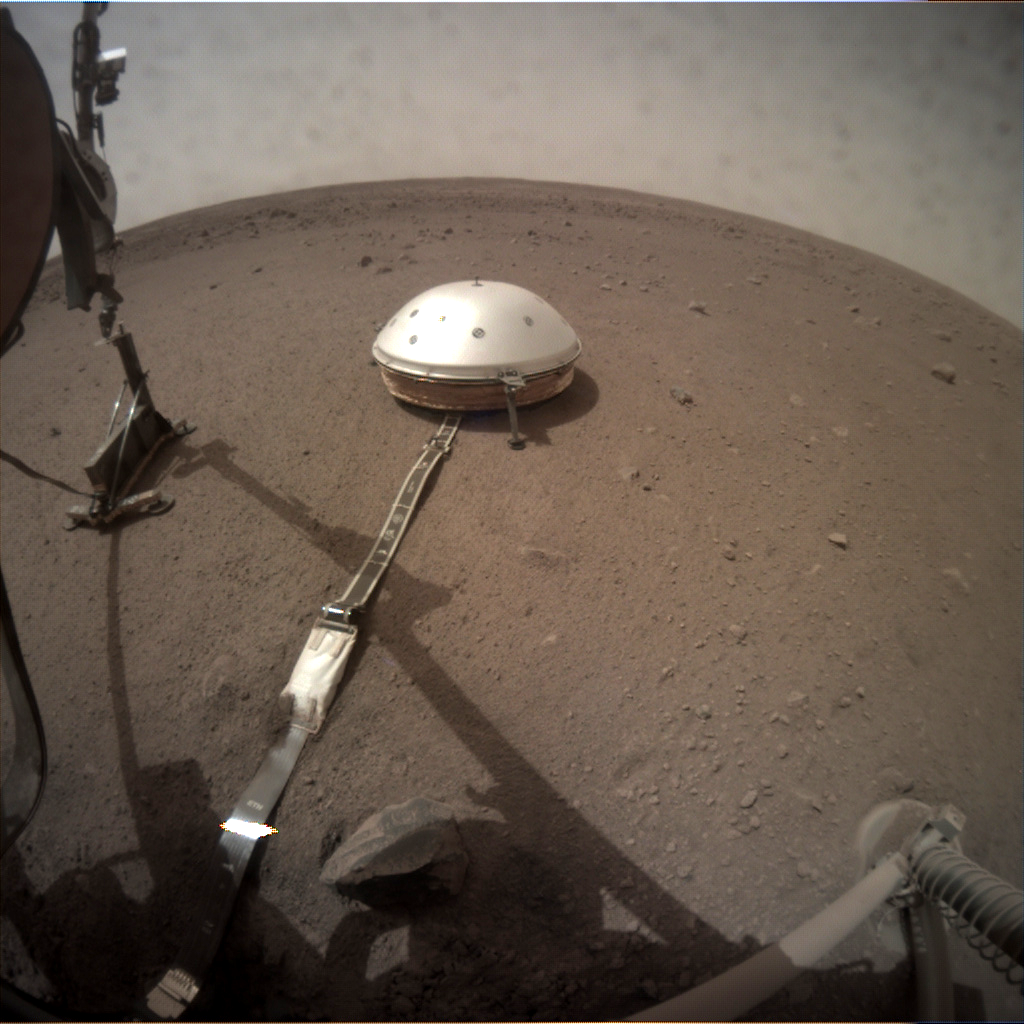
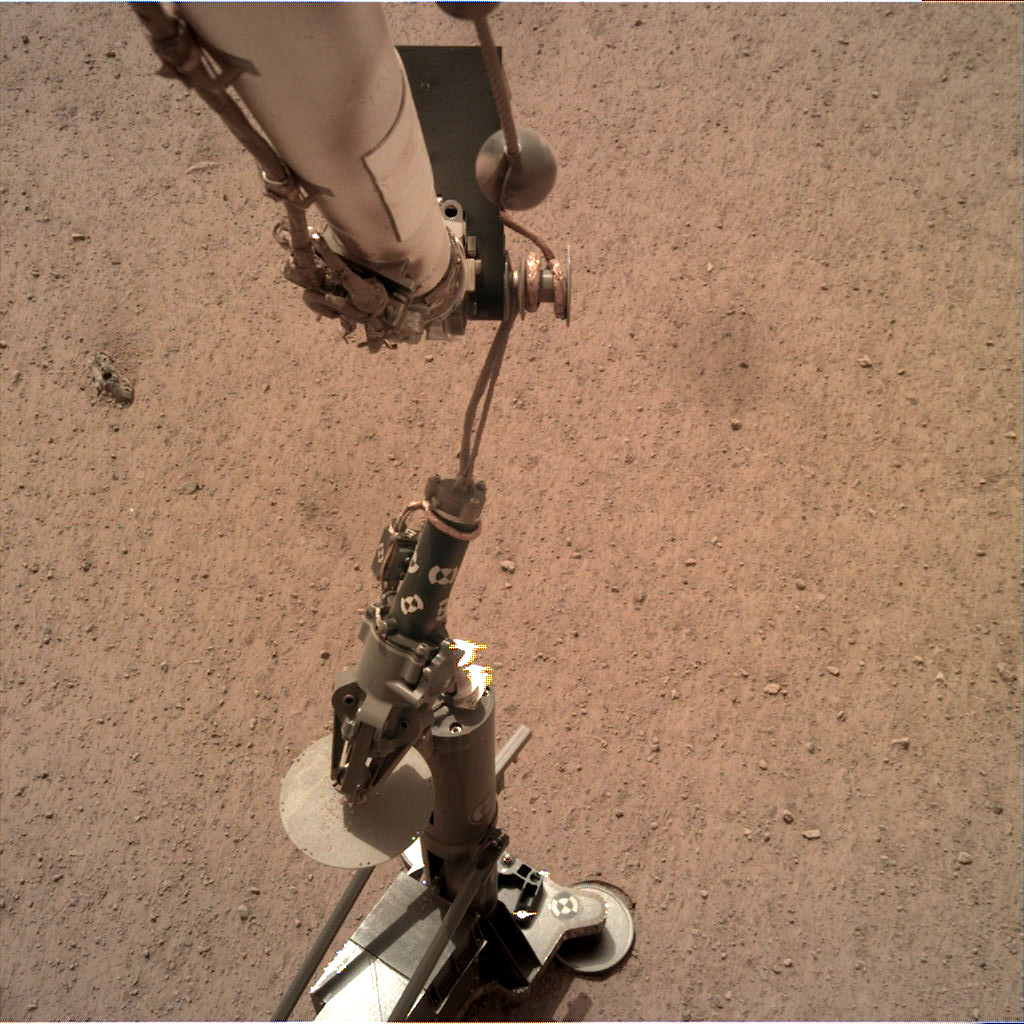
I wonder what happened with the positioning of the arm though. The grapple is hanging at an odd angle now.
DLR is happy:
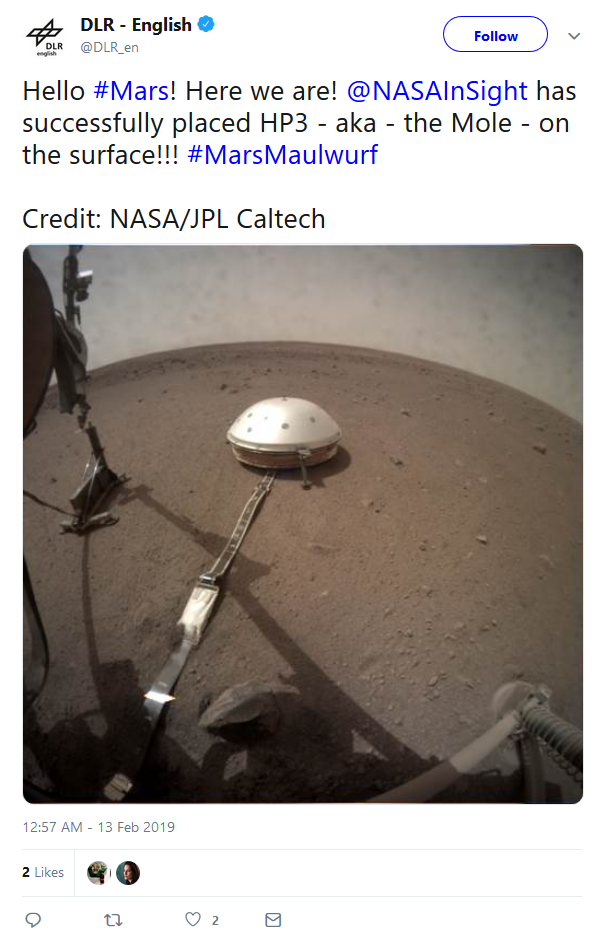
Link to DLR tweet.
I wonder what happened with the positioning of the arm though. The grapple is hanging at an odd angle now.
DLR is happy:

Link to DLR tweet.
It's a lot closer to SEIS than I was expecting.
Heck yes. Looks scary close to a super sensitive seismometer. But in hindsight, it could never be very far away and I'm sure the dynamics are well understood.
There's a new article on the Insight page though doesn't say much new other than it being deployed ~1 meter from SEIS
That's a good one Olivier...I mean, the Panettone 
Grapple/grapes?
Grapple/grapes?
From a scientific point of view, I have to admit that I may have been a little bit over enthusiastic with the last sentence of the WTS news quoted just above !
The longform posts on the SEIS News page have been wonderful, thanks for taking the time to bring us along!
Simple animated GIF using processed IDC images from sols 79 & 81, they have better aligned the mast over the instrument to prevent dragging HP-Cubed when they release the grapple.
Click to view attachment
As I promised more than one month ago, I'm working on an alternative viewer for InSight images. Right now can be reached here: http://www.nahumchazarra.com/insight/datos.php
It's in a very early alpha phase, but it's working. If you have any suggestions, I'll be glad to hear them.
It's in a very early alpha phase, but it's working. If you have any suggestions, I'll be glad to hear them.
Looks good. One suggestion is using thumbnails rather than presenting the full-size images small, so the page would load more quickly. But you'd need a script to generate and store them, since the NASA site doesn't seem to have any. Somewhat larger thumbnails would be nice, more like what Midnight Planets or curiosityrover.com use.
The "fetcha" column is just the time the image was taken, from the individual image descriptions on the NASA Insight page, right? Older images may sometimes appear on the NASA site. It would be nice to also show (and be able to sort on) the time the image was received on Earth, or at least the time it appeared on the NASA site. Sorting on the arrival time would mean you wouldn't miss any older images that showed up late. It should be sufficient to use the time your skimmer code first found the image.
The "fetcha" column is just the time the image was taken, from the individual image descriptions on the NASA Insight page, right? Older images may sometimes appear on the NASA site. It would be nice to also show (and be able to sort on) the time the image was received on Earth, or at least the time it appeared on the NASA site. Sorting on the arrival time would mean you wouldn't miss any older images that showed up late. It should be sufficient to use the time your skimmer code first found the image.
Thanks for the suggestions, Fredk!
I'll be downloading the images and creating a thumbnail for the next version. I also plan for creating a new grid to search the images more easily. The "fecha" field is the date and time the image was taken, but I couldn't find any field with the arrival date/time of the image. I hope when the images are uploaded to the PDS I'll be able to extract more metadata.
I might also be doing an iffft receipt for creating some warning when new images arrive.
I'll be downloading the images and creating a thumbnail for the next version. I also plan for creating a new grid to search the images more easily. The "fecha" field is the date and time the image was taken, but I couldn't find any field with the arrival date/time of the image. I hope when the images are uploaded to the PDS I'll be able to extract more metadata.
I might also be doing an iffft receipt for creating some warning when new images arrive.
For the English speakers here, "fecha" means "date" 
Thank you so much for creating this, Nahum! It's always a pleasure to see people spending their time to create something that will benefit so many other people.
You might consider creating columns based on the file names that would pull out information on the mesh, mosaic, and stereo/mono nature of each image:
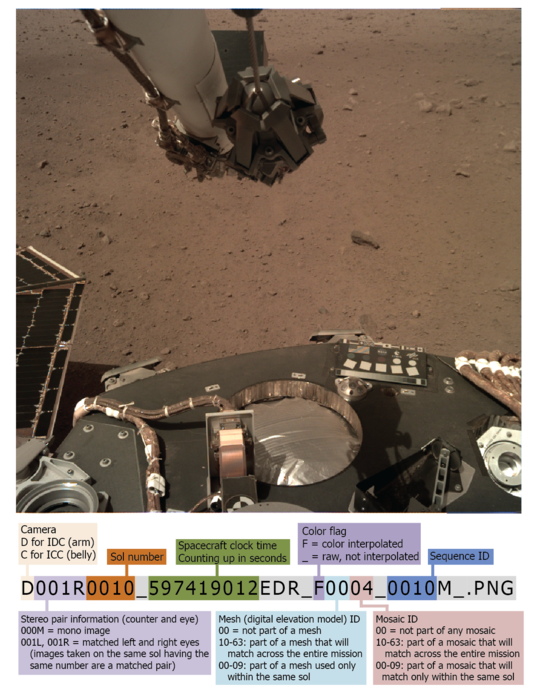
Thank you so much for creating this, Nahum! It's always a pleasure to see people spending their time to create something that will benefit so many other people.
You might consider creating columns based on the file names that would pull out information on the mesh, mosaic, and stereo/mono nature of each image:

Thanks Emily!,
I totally forgot to edit the fields of the grid and translating them to english because I was programming in spanish. For the next version I will improve the grid (and the headers will be completely in english), and also I will use the filename convention to add more data to the images. Thanks for the suggestions!
I totally forgot to edit the fields of the grid and translating them to english because I was programming in spanish. For the next version I will improve the grid (and the headers will be completely in english), and also I will use the filename convention to add more data to the images. Thanks for the suggestions!
HP3 released: Processed IDC image from sol 83
Click to view attachment
Click to view attachment
Good! Now let's hope for a full panorama.
Phil
Phil
Possibly dumb question - can the mastcam look under the deck in the same way as Phoenix could?
I'm not expecting to see sheets of ice in this near-equatorial location , but is it possible that at some parts of the year, perhaps in the early morning,
, but is it possible that at some parts of the year, perhaps in the early morning,
there might be enough atmospheric moisture to condense water on the body of the lander?
Currently reading this new paper to see if it can suppluy some clues...
https://arxiv.org/pdf/1902.07772.pdf
P
I'm not expecting to see sheets of ice in this near-equatorial location
there might be enough atmospheric moisture to condense water on the body of the lander?
Currently reading this new paper to see if it can suppluy some clues...
https://arxiv.org/pdf/1902.07772.pdf
P
Something like this?
Ahh, I somehow missed that one! Thanks Hungry.
P
P
Animation of some sol 85 pictures of HP3: the parallax between pics gives a nice 3D effect 
Click to view attachment
Click to view attachment
The InSight DLR HP3 blog has a new home:
Here is the latest logbook entry: dated 24th February 2019 from the instrument lead (Tilman Spohn)
I received confirmation this morning from our System Engineer Jörg Knollenberg that the mole release was successful! That is the mole is now free of its fixation that was protecting it until now from any unwanted movements. It is now ready to go! Tomorrow, Monday the 25th of February, there will be a formal review by the operations team and then the command for the mole to start hammering will be included into the list of commands that will be sent to the lander tomorrow afternoon. Hammering operations will then commence on 10 am Local Mars Time which will be Tuesday shortly before 7 pm pacific or shortly before 2 am in Germany. A confirmation of the successful hammering is expected to be uplinked with the late afternoon pass of the TGO (Trace Gas Orbiter from ESA) which will be at 8:45 am PST or 17:45 MEZ.
new link English & German
Here is the latest logbook entry: dated 24th February 2019 from the instrument lead (Tilman Spohn)
I received confirmation this morning from our System Engineer Jörg Knollenberg that the mole release was successful! That is the mole is now free of its fixation that was protecting it until now from any unwanted movements. It is now ready to go! Tomorrow, Monday the 25th of February, there will be a formal review by the operations team and then the command for the mole to start hammering will be included into the list of commands that will be sent to the lander tomorrow afternoon. Hammering operations will then commence on 10 am Local Mars Time which will be Tuesday shortly before 7 pm pacific or shortly before 2 am in Germany. A confirmation of the successful hammering is expected to be uplinked with the late afternoon pass of the TGO (Trace Gas Orbiter from ESA) which will be at 8:45 am PST or 17:45 MEZ.
new link English & German
I just had to say it :
" Hammer Time !! "
" Hammer Time !! "
Hopefully, this time around, no one will trip over the cable for the heat flow experiment.
but how cool would it be if someone did! 
Yes, but to discuss this further would be in violation of rule 1.3!
No hammering today, the uplink was missed.
https://www.dlr.de/blogs/en/all-blog-posts/...on-logbook.aspx
https://www.dlr.de/blogs/en/all-blog-posts/...on-logbook.aspx
InSight HP3 PI's mission log has been updated with new schedule of the mole deployment and thermal conductivity tests in the coming days.
It also reports on a chance to measure the thermal effect of a Phobos eclipse on the surface temperature with their radiometer on Sunday
link to mission log updated on February 27, 2019
Referenced HRSC image of Phobos's shadow on Mars in 2005
Click to view attachment
It also reports on a chance to measure the thermal effect of a Phobos eclipse on the surface temperature with their radiometer on Sunday
link to mission log updated on February 27, 2019
Referenced HRSC image of Phobos's shadow on Mars in 2005
Click to view attachment
Sol 92 images appear to show evidence of vibration caused by the mole around the foot pads. Note the disturbed regolith 
Click to view attachment
Click to view attachment
I noticed the disturbed regolith as well. If all went according to plan, the mole is now at a depth of 70 cm, if I understood the mission log posted by PaulH51 correctly.
EDIT: New blog post up at DLR: The InSight mission logbook
The mole reached a depth of at least 18 cm but less than 50 cm after the full four hours of hammering. It encountered an obstacle which it might have pushed aside after 3,5 hours. The mole is now 15 degrees inclined with the vertical.
EDIT 2: More news at the DRL page: Good luck ‘Mole’ – DLR’s HP3 experiment starts hammering into the Martian soil
Looks like it encountered another stone after the first one. In a couple of days, they will command another four hours of hammering.
EDIT: New blog post up at DLR: The InSight mission logbook
The mole reached a depth of at least 18 cm but less than 50 cm after the full four hours of hammering. It encountered an obstacle which it might have pushed aside after 3,5 hours. The mole is now 15 degrees inclined with the vertical.
EDIT 2: More news at the DRL page: Good luck ‘Mole’ – DLR’s HP3 experiment starts hammering into the Martian soil
Looks like it encountered another stone after the first one. In a couple of days, they will command another four hours of hammering.
Wow, that sandy-looking soil proved to be tougher than we might have hoped.
I am wondering - if an obstacle is encountered before the probe is even fully into the regolith, do they have any means of redeploying to try another spot?
I fear not, but of course still hoping we can break through in this location.
I am wondering - if an obstacle is encountered before the probe is even fully into the regolith, do they have any means of redeploying to try another spot?
I fear not, but of course still hoping we can break through in this location.
Not sure if it's plausible to redeploy the instrument once it's release. There's no way to draw it back up, is there?
Animated GIF cropped from processed ICC frames from sols 89 & 92. It shows the movement of HP3 after the mole was released, I selected these frames because of the similar solar time.
Click to view attachment
Click to view attachment
"Tests with pebbles in sand suggest that the mole takes some hours but can work itself through a layer of pebbles or move a stone out of the way. Geological evidence suggest that the regolith should be mostly sandy. So hopefully we can get past the obstacle on Sunday and get to 70 cm more easily. But we should not forget, we are moving into the unknown." DLR Blog
Do any of the geologists here have an idea whether there could be a layer of relatively impenetrable consolidated material — e.g., a natural cement — that, unlike pebbles or stones, makes it difficult or impossible for the mole to move it or go around?
Do any of the geologists here have an idea whether there could be a layer of relatively impenetrable consolidated material — e.g., a natural cement — that, unlike pebbles or stones, makes it difficult or impossible for the mole to move it or go around?
IDC GIF with processed frames from 87, 92 & 94 shows more movement of the HP3 support structure after the second hammering attempt. The PI blog dated March 3, 2019 only appears to have provided additional details on the 1st attempt
Click to view attachment
Click to view attachment
Not a geologist, but I have been wondering about duricrusts. IIRC, Elysium is primarily a volcanic province but sand covers all on Mars. There could well be ancient evaporite deposits almost anywhere beneath the surface, I'd imagine.
This is a "lo-fi" version of our main content. To view the full version with more information, formatting and images, please click here.

